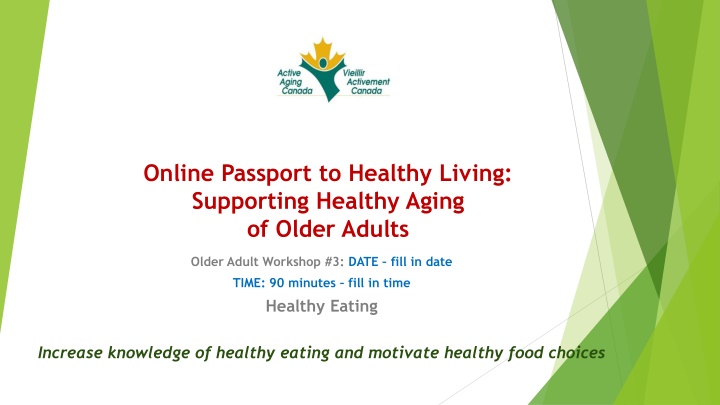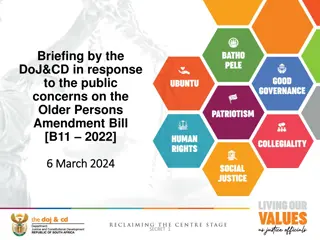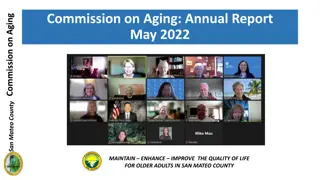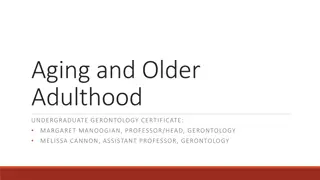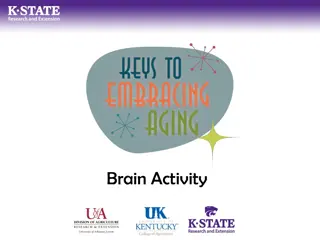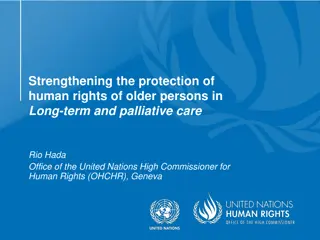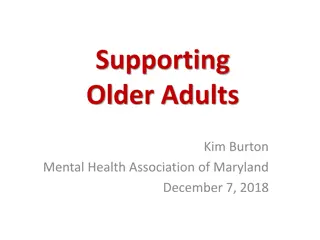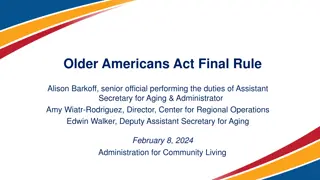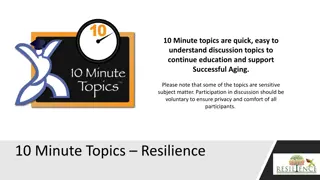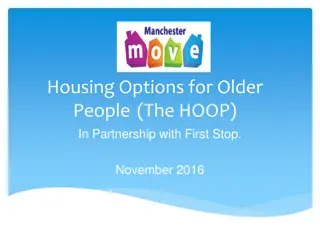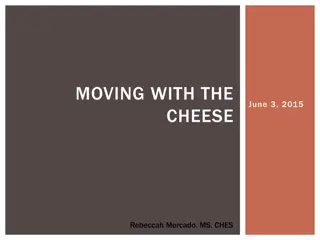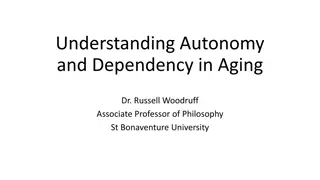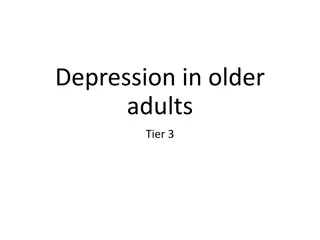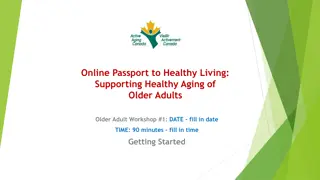Supporting Healthy Aging Through Nutrition: Older Adult Workshop #3
Empower older adults to make healthy food choices by increasing their knowledge of healthy eating habits in a supportive workshop setting. Topics covered include discussions on the Canada Food Guide, understanding food labels, setting SMART goals, and creating action plans for a healthier lifestyle.
Download Presentation

Please find below an Image/Link to download the presentation.
The content on the website is provided AS IS for your information and personal use only. It may not be sold, licensed, or shared on other websites without obtaining consent from the author.If you encounter any issues during the download, it is possible that the publisher has removed the file from their server.
You are allowed to download the files provided on this website for personal or commercial use, subject to the condition that they are used lawfully. All files are the property of their respective owners.
The content on the website is provided AS IS for your information and personal use only. It may not be sold, licensed, or shared on other websites without obtaining consent from the author.
E N D
Presentation Transcript
Online Passport to Healthy Living: Supporting Healthy Aging of Older Adults Older Adult Workshop #3: DATE fill in date TIME: 90 minutes fill in time Healthy Eating Increase knowledge of healthy eating and motivate healthy food choices
Land Acknowledgment Example: We acknowledge the land that we are meeting on today is the traditional territory of many nations including the Mississaugas of the Credit, the Anishnabeg, the Chippewa, the Haudenosaunee and the Wendat peoples and is now home to many diverse First Nations, Inuit and Me tis peoples. We also acknowledge that Toronto is covered by Treaty 13 signed with the Mississaugas of the Credit, and the Williams Treaties signed with multiple Mississaugas and Chippewa bands.
Introductions Your name, Facilitator Introductions if there are new members Name Organization and location Hopes for the workshop series Session 1: Online Passport with Older Adults 3
Best Practice Guidelines - Zoom Today s session is 90 minutes long, with a 10 minute break in-between Presentations are in the morning stretch as you wish Small groups and large groups will enable interaction and brainstorming In discussions, one person speaks at a time Use the hands up reaction if you wish to speak Please remember to turn your mic off if you are not speaking If not speaking, turn off your video to save your bandwidth, e.g. during presentations, or if your internet connection is a little unstable Reboot your computer before the next session to maximize function This is a safe space, and we welcome honest, open and respectful discussions
Agenda Segment 1 & 2 9:15 - Login in to Zoom for system check of mics, speakers Once complete, pause and get your coffee/tea! 9:30 - Welcome Review Module 3 agenda and objectives 9:35 - Reflection and Group Check-in Lifestyle goals Break out Rooms 9:50 - Discuss Canada Food Guide and Healthy Eating 10:00 - Small Group Discussion Eating habits and challenges Break out Rooms 10:20Break 10:30 Video about Food Labels and discussion 10:35 Small Group Discussion Goal setting and Action Plan (15 mins) 10:55 Final thoughts and Evaluation 11:00 - Closing
Overview of Session #2: SMART Goals S = Specific M = Measurable A = Attainable R = Realistic T = Timely Example: I will drink 8 glasses of water throughout the day Goal setting the purpose is to make a change, no matter how small!
Reflection (10 minutes) 1. Discuss your lifestyle goal and your daily dose activity. Is your goal SMART? What pros/cons factors are you experiencing? What are your strategies for success? How are you overcoming barriers? Choose one speaker to report back to the group about how you are overcoming your barriers Instructions Copy questions before going to breakout rooms Decide on a reporter The reporter will report back to larger group
Group Check-in (5 minutes) Report on your lifestyle goal and your daily dose activity: How are you overcoming barriers? (1 speaker from each breakout room reports back to the full group)
PURPOSE: Increase knowledge of healthy eating and motivate healthy food choices OBJECTIVES: To build on participant knowledge of healthy eating To increase awareness of the barriers to making healthy food choices To identify ways to make healthy eating easier
Poll: Canada Food Guide What are your thoughts on the Canada Food Guide?
Healthy Eating: Canadas Food Guide (2019) Why healthy eating information matters: Disease Risk Unhealthy diet primary risk factor for disease in Canada Complex Nutrition information can be difficult to understand Confusing Conflicting healthy messages everywhere Credible Canadians need credible healthy eating information
Healthy Eating: Canadas Food Guide (Previous Versions)
Healthy Eating: Canadas Food Guide Updates The updated Food Guide eliminates the traditional four food groups and emphasizes on 3 food groups: Fruits and vegetables Whole grains Proteins The updated Food Guide encourages Canadians include half of their daily diet of fruits and vegetables, and split the remaining half between whole grains and proteins Modified the protein food group to include dairy and meat as well as plant- based proteins
Healthy Eating: Canadas Food Guide (2019) Healthy eating is more than just the food you eat! Be mindful of eating habits Notice when you are hungry and when you are full. Cook more often! Involve others in planning and preparing your meals. Enjoy your food. Culture and traditions can be part of healthy eating. Eat meals with others. Share food traditions across generations and cultures.
Healthy Eating: Tips for Healthy Eating Pages 22-27 of your Passport Enjoy a variety of foods from each food group. Drink water throughout the day to avoid dehydration. Make water your drink of choice. Avoid pop and fruit juice! Eating regularly helps the body control blood sugar levels. Foods high in fibre may help control blood sugar and cholesterol levels. Fibre also helps keep us healthy! Limit highly processed foods by preparing meals at home, and look for healthier options when eating out. Remember, small changes can make a big difference!
Healthy Eating: Your Plate Pages 26-27 of your Passport Include plenty of fruits and vegetables on your plate. Don t be afraid to try something new! Try making proteins a quarter of your plate and opt for lean meats and plant-based products like tofu and lentils. Choose whole grain breads, pasta and cereals. Whole grains include all parts of the grain, and have more fibre. Make changes slowly. If you like sweets, cut down on them gradually, rather than trying to do it all at once. Small changes are key to setting a goal!
Breakout Room Eating Habits (10 minutes) In 3 small groups have a discussion on your eating habits. What challenges do you see with the eating habits outlined in the Passport (pgs 22- 27) and the Canada Food Guide? Please give examples. (5 mins) Brainstorm about ways to overcome these barriers. These might include: cost, time, boredom, eating alone, etc. (5 mins) Choose a speaker and report 1 new key barrier and solution from each group (5 minutes) Instructions Copy questions before going to breakout rooms Decide on a reporter The reporter will report back to larger group
Breakout Room Eating Habits Challenges and Barriers: Solutions:
Daily Dose Activity Desk Stretches Sitting up straight, bring your hands to rest at the base of your skull, fingers intertwined Inhale deeply. As you exhale, ease your left elbow so it s pointing more toward the ground, your right elbow toward the ceiling. This will stretch your neck in a supported way. Note: This should be an easy movement, so if it s a slight movement and your elbows only move an inch or 2, that s fine. Take 2 deep breaths and ease yourself back to neutral, spine upright. Repeat on other side, right elbow toward the ground, left elbow toward the ceiling. Do this 3 times on each side, alternating sides as you go.
Nutrition Break 10 minutes Facilitator s favourite meals: You can fill in yours Chia seed Overnight Oats with cocoa and strawberries Garlic hummus with baked pita and carrots Apples with peanut butter Baked Kale chips During the break, think of your favourite nutritious meal and share it in the chat!
Agenda Segment 2 10:20 Break 10:30 Video about Food Labels and discuss 10:35 Small Group Discussion Goal setting and Action Plan (15 mins) 10:55 Final thoughts and Evaluation
News Bites Healthy Aging (5 minutes) Has anyone seen, heard or read any news bites of interest regarding healthy aging? Do we know who wrote it? Do we know their qualifications? Are the sources they are using credible? Is the source providing the news credible? What is Credible? worthy of belief or confidence; trustworthy: e.g. a credible website.
Food Labels Video https://www.youtube.com/watch?v=l_KzgrD3NYU Select a package of food from your kitchen and explore the label for: Serving size Calories % Daily value Nutrients
Action Plan for Healthy Lifestyle Achievable something you can do in the next month Action-specific (write steps as behaviors - losing weight is not a behavior but avoiding snacks between meals is a behavior). Answer the questions: What? How much? (e.g., walking four blocks). When? (e.g., after dinner or Monday, Wednesday, Friday or four times; try to avoid every day ). How often? What is needed to put the plan into action and keep it in action? Is it realistic? Revise if necessary Setting goals and having an action plan is critical to success. Writing an action plan is a process which will help you to focus your ideas and to decide what steps you need to take to achieve your goals. When you write your Action Plan make the goal(s) something you can and WANT to do. Make the steps something you can do in the next month. Writing it down makes it real! Decide what YOU want to do
Action Plan Template Retrieved from Strategies to Support Self-Management in Chronic Conditions: Collaboration with Clients Best Practice Guidelines PDF Version available as a handout Name:___________________________________________________ Date:______________________ The change I want to make happen is:_____________________ My goal for the next month is:________________________ The specific steps I will take to achieve my goal are (include what, when, how, where, and how often): _____________________________ The things that could make it difficult to achieve my goal include:____________ My plan for overcoming these challenges include:_______________ Supports and resources I will need to achieve my goal include:________________ My confidence that I can achieve my goal is: ____________________________ . (scale of 0 to 10, with 0 meaning not confident at all, and 10 being extremely confident)
Discussion Small Groups Breakout Room (10 minutes) Action Plan In your breakout rooms, discuss the following: The change I want to make happen small change Overall health goal The Big Picture Specific steps to achieve my goal (what, when, how, where, and how often) Barriers to achieve goal and how to overcome them Choose a speaker, and report 1 new change, barrier and solution from each group (5 minutes)
Discussion Small Groups Breakout Room Healthy Goal Action Plan Change Barrier Solution
Final Thoughts All or Something Round Table Discussion What is one thing you learned? What is one question you still have? What word describes how you are feeling? Please enter your response in the chat
Evaluation Workshop Objectives To build on participant knowledge of healthy eating To increase awareness of the barriers to making healthy food choices To identify ways to make healthy eating easier Did the workshop meet the objectives? (Use Annotate functions) 1. Yes 2. No
Evaluation What did you enjoy? What could be improved? Aspects that you enjoyed Improvements?
